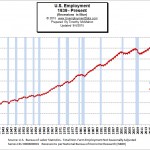 The BLS issued their “preliminary estimates” for the employment situation for the month of August 2015. The Commissioner’s report regarding the Seasonally Adjusted numbers says, “Nonfarm payroll employment increased by 173,000 in August, and the unemployment rate edged down to 5.1 percent. Employment rose in health care and social assistance and in financial activities, while manufacturing and mining employment declined.”
The BLS issued their “preliminary estimates” for the employment situation for the month of August 2015. The Commissioner’s report regarding the Seasonally Adjusted numbers says, “Nonfarm payroll employment increased by 173,000 in August, and the unemployment rate edged down to 5.1 percent. Employment rose in health care and social assistance and in financial activities, while manufacturing and mining employment declined.”
The full report of unadjusted numbers states that there were 142.126 Million jobs in August compared to 141.794 million jobs in July and 142.868 million jobs in June.
See Current Employment Commentary for more information.
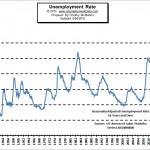 The U.S. Bureau of Labor Statistics (BLS) also released the newest unemployment data for August 2015 today. According to the BLS, the current “Seasonally Adjusted” Unemployment Rate for July is 5.1% down from July’s 5.3%. The BLS reported the “Unadjusted” Unemployment Rate is 5.2% which is lower than July’s 5.6% . See Current Unemployment Chart for more information.
The U.S. Bureau of Labor Statistics (BLS) also released the newest unemployment data for August 2015 today. According to the BLS, the current “Seasonally Adjusted” Unemployment Rate for July is 5.1% down from July’s 5.3%. The BLS reported the “Unadjusted” Unemployment Rate is 5.2% which is lower than July’s 5.6% . See Current Unemployment Chart for more information.
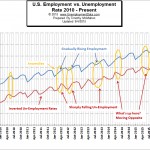
U3 vs. U6 Unemployment
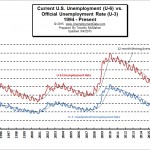
Historical Employment Levels Compared to Recessions

Generally, recessions correspond pretty well to declines in employment (i.e. increased Unemployment). This is especially true since unemployment is one of the major factors NBER uses to determine whether there is an official recession. This chart shows the actual number of jobs in addition to showing recessions shaded blue as per the official description of a “recession” by the National Bureau of Economic Research (NBER).See Employment During Recessions for more information.
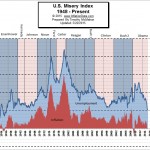
The two factors it uses are inflation and unemployment. High levels of price inflation (rapidly rising prices) will cause households to have difficulty affording the basic necessities while high unemployment will leave a high percentage of households without any income at all. High combined levels will cause havoc throughout the economy and a high level of distress, discomfort and political unrest. See Misery Index.
Seasonal Adjusting
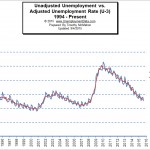
What is the “Real” Unemployment Rate?
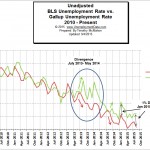
- Monthly Historical Unemployment Rates from 1948 through the present.
